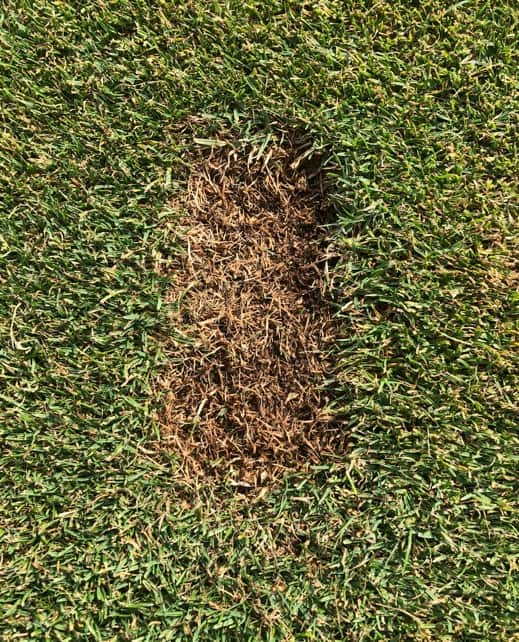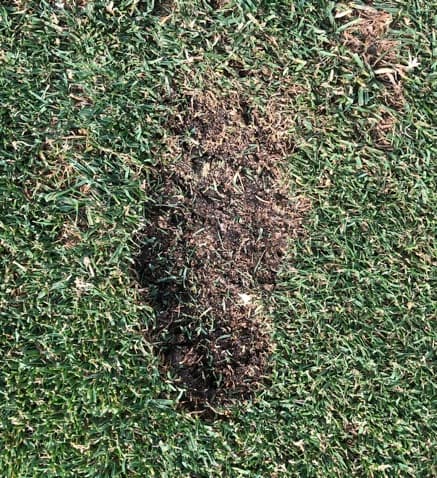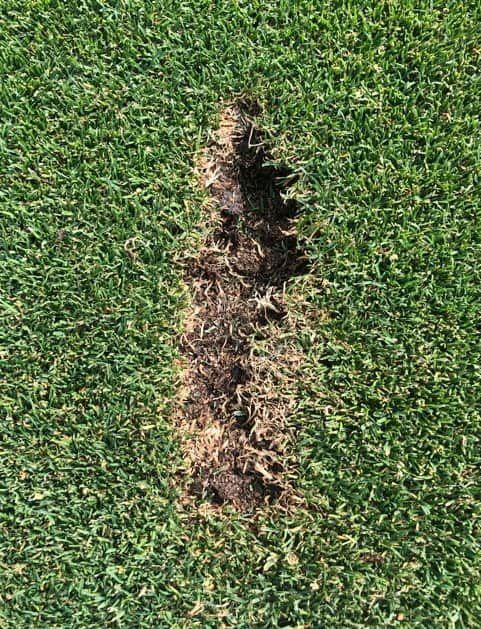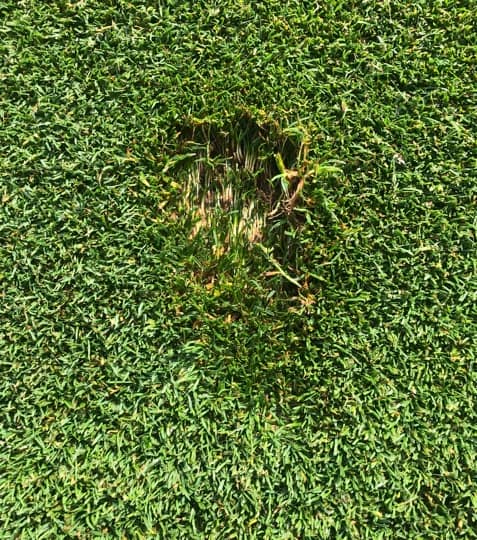Taking a proper divot in golf is a strong indicator of a good golf swing. Understanding how your divot is made can help you analyze and improve your golf swing.
Everyone can make a divot but when you see the professional golfers hit iron shots, you see a nice intact perfectly symmetrical divot go flying in the air. Most amateurs either don’t create a divot but rather take more of an impact strip in the ground. If they do take a divot, it’s usually not symmetrical and too deep in certain areas. You will also likely lose distance when not making a proper divot.
Let’s first understand how a divot is made.
Divots are Made Indirectly
In this game, anything forced is always a bad thing in golf. When someone focuses on making a divot as a goal, the outcome is never what you want. This means that the golfer just doesn’t understand the concept of making divots. They are made by good consistent swings while using fundamentals so you want to focus on making your swing better by good weight transfer forward and a more shallow plane on the downswing. This will surprise most golfers on how proper divots are made.
Why a Consistent Divot Will Make Your Swing Consistent
If you were to analyze your divot after it was made, you should see that it started just ahead of where the ball was set up at. So the clubface made contact with the ball first and then went through it on a slight downward angle to also go through the turf. This will create better and consistent contact because of the angle of the clubface at impact that is made by transferring your weight to your target side.
Clearing your Hips before Impact
This is a big fundamental of the golf swing so if you don’t think you do this well or at all, this should help you understand how to improve your swing while creating better contact and a nice divot. Below are results of how clearing your hips and transferring your weight can help.
- Transferring more weight towards your target side to create more power
- Creates a more shallow downswing to create lag and a better shaft flex
- Allows your clubhead to make impact with less loft to create a slight downward motion at impact.
- Give you the opportunity to release your hands and arms with better extension through impact
Keep an Eye on Your Lead Shoulder
The most common fault of golfers is that they either come up with their entire body at impact or hang back on the back side. The lead shoulder will likely rise from where you set up which will prevent your body and hips from clearing.
To prevent this, make sure your lead shoulder is not set up “high and tight” at setup and keep it looser through your swing. I explain to my students that this is a Roadblock in your swing. This will result in an inconsistent swing with your body compensating power, distance and accuracy just in order to make decent contact.
Below are the reasons why you are not making a proper divot.
- Casting the club is the result of your hands pulling club down from the top and not your hips leading
- Early club release so your hands will help make contact with ball by flipping at it
- Your momentum through impact is more UP than Down and Through
- Weight will be more on your toes at impact which will result in an unbalanced finish
Clubface De-lofts at Impact
If you are hitting a 7 iron the loft may be around 35 degrees. When you make impact with the ball, the club loft should be less and the “dynamic” loft should be closer to 22 degrees (PGA Tour average). This is caused by your hands being more in front of the ball at impact. The proper flex of the shaft which is slightly bent at impact helps maximizes the clubhead speed to send the ball higher and divot farther.
Proper Divots Fly Farther
Let’s get one thing out of the way, the steeper you come down on the backswing may make a divot but not the way you want to make it. Your divot will most likely land about 5-10 ft away from where you made it. If you do it the right way, your divot will be level and symmetrical as it usually goes flying a good distance (15-25 ft) ahead towards your target. So you want to release the club with good clubhead speed through impact which can produce a personal-record flying divot.
Not all Irons Make Divots
Divots are usually made from your mid-irons through your wedges. You will swing all of your irons the same but the ball positions are in different places in your set-up stance so when the ball is more forward of your setup center, you will most likely make less of a divot or not at all. If your ball is set up in the middle of your stance like your 7 iron and on down, you should be making the proper divots while making impact on a slight downward motion.
Your Divot is Your Golf Swing Calling Card
Looking at your divot can tell me a lot about your golf swing. When I see a nice rectangular level divot, that is usually made from a good swing. When I see a more narrow thinner divot, that tells me that the clubface did not come through contact squarely all the way through the impact.
Here are the different types of divots and what they mean. Take notice of your own divots to help understand your swing – and anyone else’s.
Golf Divot Types
Perfect Rectangular Level Divots

This is the result of the clubface coming in square when making contact with the golf ball and through impact while the clubface is delofted and enters into the turf. The clubface releases all the way through impact at your target so your release is more powerful. This is the mark you want to leave – make this your “golf swing calling card”. Take a look at Par 3 tee areas after Tour Pros have finished their rounds. You will see almost all perfectly rectangular divots.
Trapezoid Divot

The divot is almost perfect but the side(s) of the divot is a bit slanted. This means that the club path was fairly square to your target but the clubhead was turning at one point through impact so it never made it through from start to finish. Usually means you will put side-spin on the ball or the ball took off in the wrong direction.
Slanted Divot

Unfortunately this divot is more common on the golf course than any other divot. When your divot is aiming left or right of your intended target, there could be various combinations of how the golf ball was hit. The various factors are the path of the clubhead coming through impact, the angle of the clubhead attacking the ball and the direction of the clubface. Coming over the top and casting the club can be reasons for making this type of divot.
Rectangular but Crooked Divot Depth
This is almost what you want but when one side of your divot is deeper than the other side means either your toe or heel of your clubhead is digging in too much than the other side. This can either mean that your club is too upright or flat or your swing plane is too upright or flat.
Square Shallow Divot

This divot doesn’t dig deep enough to take the soil and roots so this divot is mostly grass and some roots. It’s usually not replaceable as it’s more shredded than one piece. This can mean different swings but usually decent contact and the clubface not going downward at impact all the way through.
Deep Divot
This usually means that you are coming into your impact steeper than you should be. This can affect your distance and consistent contact. This can mean that you may not have proper body rotation but more brute force by hitting the ball more with the hands and arms. Loosening up your grip pressure during the swing will help.
Summary
I hope this post explains what your divots say about your golf swing. Whether it’s a good divot or a bad divot, stay in the present and try to learn from each shot. And if you want to take things a step further in your game, check out our post on which golf ball is best for your swing type.
So now that you’ve taken your perfect divot, please follow my post on how to fix your golf divot!

